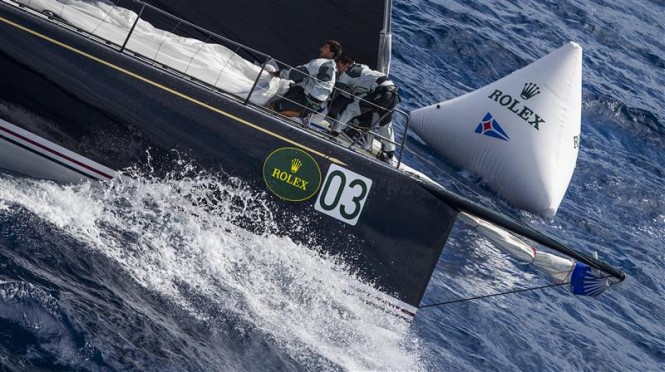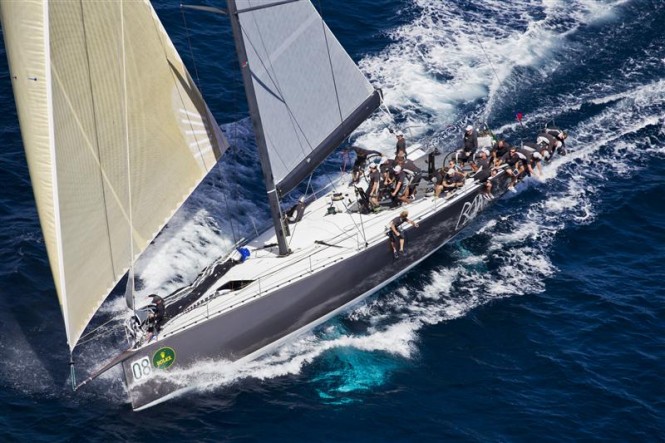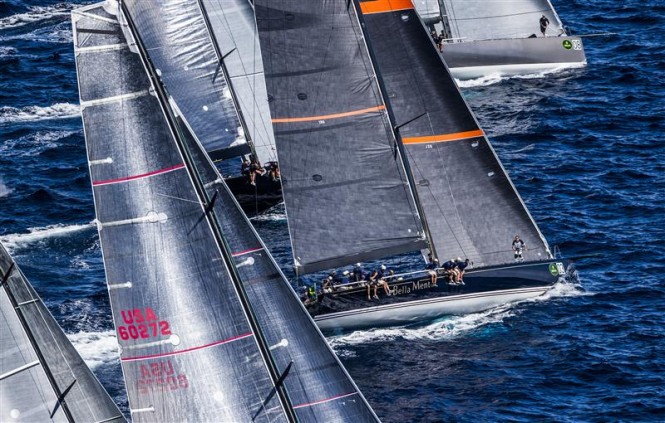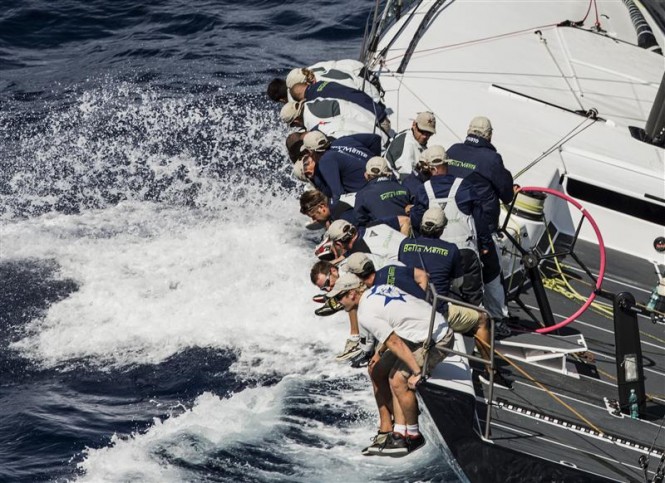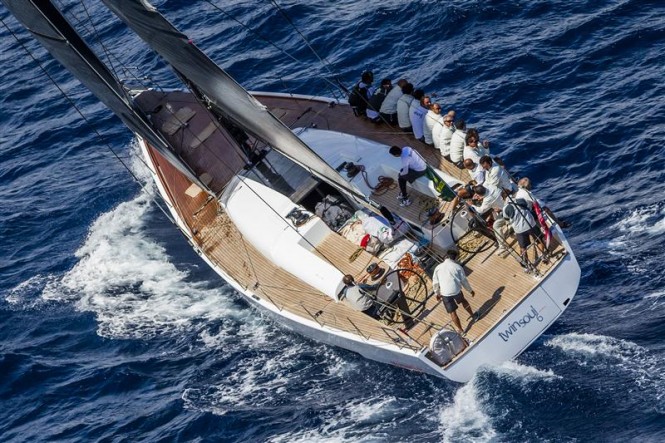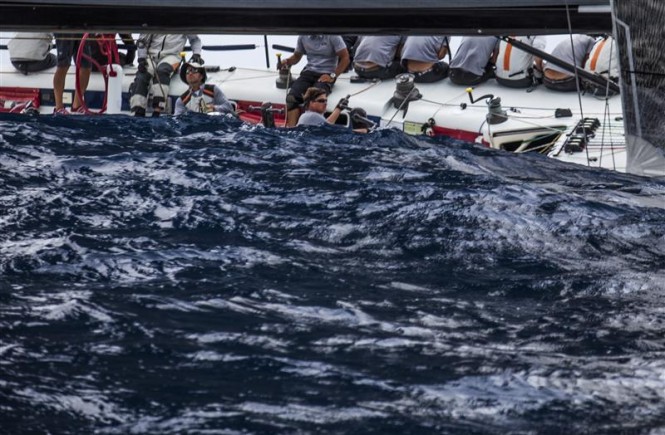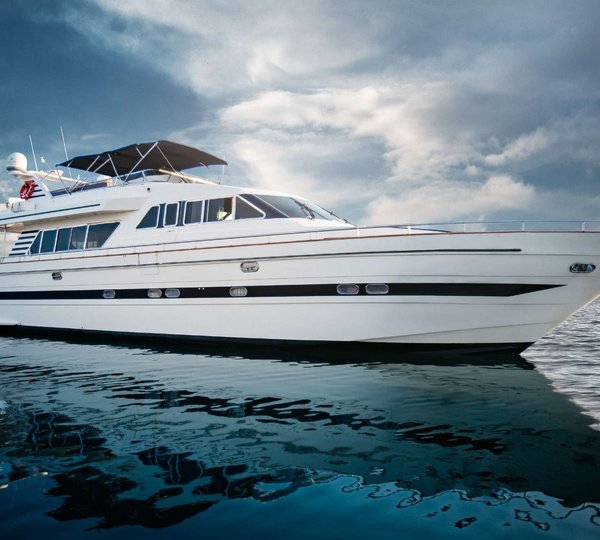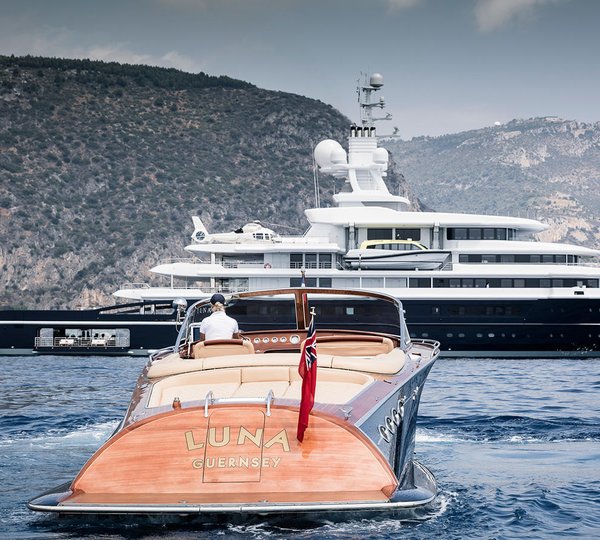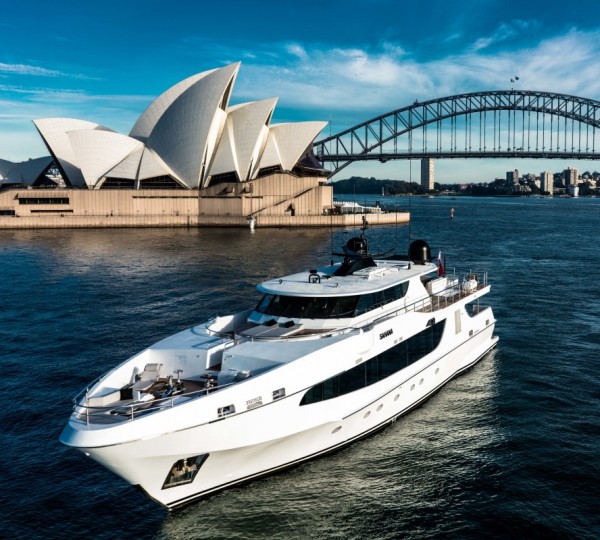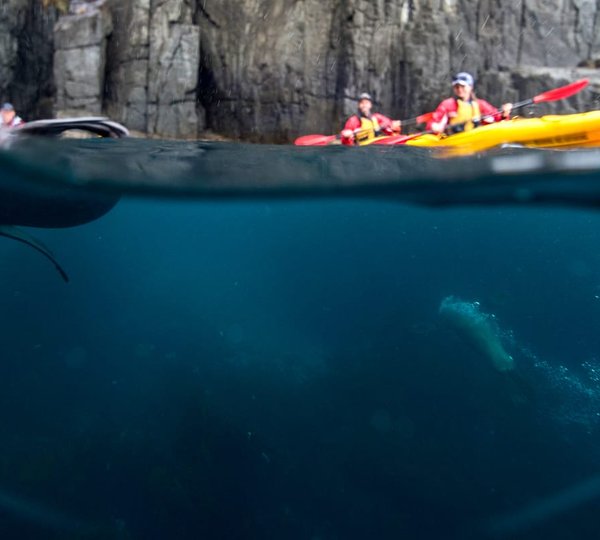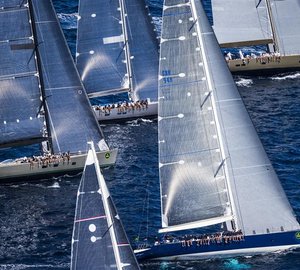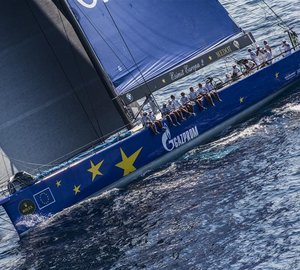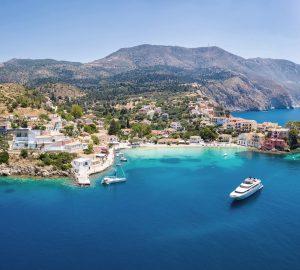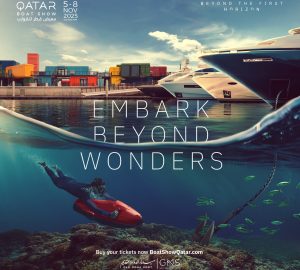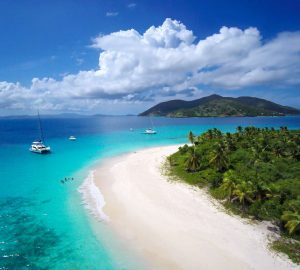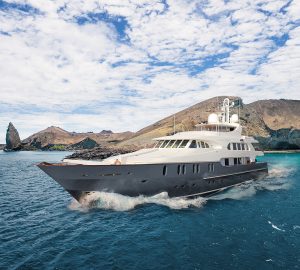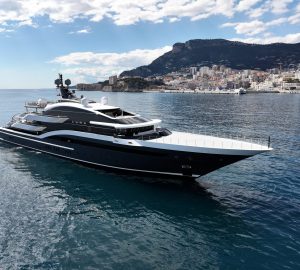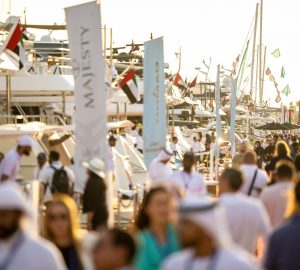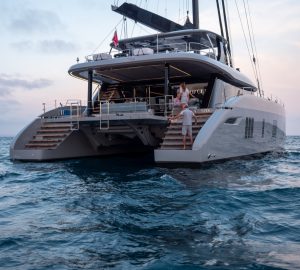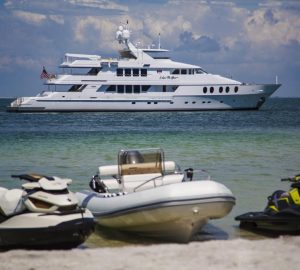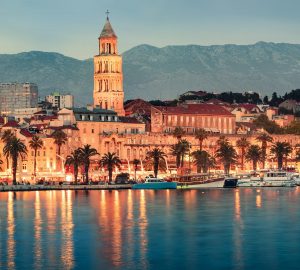Taking place in Porto Cervo every year, the Maxi Yacht Rolex Cup in Sardinia is both one of the world’s best known sailing competitions as well as the showcase for the latest in yacht design trends and technology. There are over 30 of the world’s most magnificent monohull yachts, known as Maxis, taking part in the race, measuring upwards of 18.29 metres (60ft) in length. The Maxi Yacht Rolex Cup is taking place from 2-8 September this year.
Owned and helmed by individuals used to success outside of sport, sailed by outstanding professional talent and designed by leading architectural visionaries, Maxi yachts are admired for their speed, elegance and power. Two forefront yacht designers, Jim Pugh of San Diego-based Reichel/Pugh and Rolf Vrolijk from German studio Judel/Vrolijk, are at this year’s Maxi Yacht Rolex Cup observing firsthand a number of their creations in action.
Judel/Vrolijk designs include four of the week’s Mini Maxi fleet (typically measuring 60-72ft) – Niklas Zennström’s sailing yacht Rán 2 (GBR), Sir Peter Ogden’s Jethou (GBR) and new launches Bella Mente (USA) and sailing yacht Stig (ITA). In addition, Judel/Vrolijk worked behind the concept and launch of the first Wally Cento – Charles Dunstone’s 100-ft sailing yacht Hamilton (GBR).
Reichel/Pugh have provided the vision behind several renowned Maxis including the 100-ft Esimit Europa 2 (SLO), which recently smashed the race record at the Giraglia Rolex Cup. Three other Reichel/Pugh Maxi designs boast current Rolex offshore race records – George David’s 90-ft Rambler at the Rolex Middle Sea Race (2007), the 100-ft yacht Wild Oats XI (a virtual sister ship to Esimit Europa 2) at the Rolex Sydney Hobart (2005) and the 112-ft Supermaxi Nilaya at the Rolex Volcano Race (2012).
Both Pugh and Vrolijk are well placed to provide an expert analysis of the evolution of the Maxi class over time, the prevailing trends and even a little of what to expect in the future.
From aluminium to carbon
Established in 1980, the Maxi Yacht Rolex Cup was born of a desire to provide the Maxi class of yacht – first prevalent during the 1970s – with an opportunity to engage in a direct competition, in a suitably challenging environment. Marking its 23rd edition this year, the competition organized by Yacht Club Costa Smeralda (YCCS) and the International Maxi Association, has been the jewel of Rolex’s international yachting portfolio since 1985.
The early Maxis, while state-of-the-art for their time, were reliant on relatively basic materials and restricted to 80 feet in length. Hulls were made of glass fibre, aluminium, sometimes even wood. Masts and rigging were constructed using metal. These early Maxis were heavy and not particularly fast; loads were high, manoeuvres ponderous and safety margins slim. A far cry from the sleek, carbon fibre-built designs of today that are fast, agile and in the right hands appear to be sailed like dinghies.
“Initially, Maxis were heavy displacement, fixed keel boats with a fairly shallow draft,” starts Pugh. The Maxis racing in Porto Cervo this week are unrecognisable from their predecessors – rules, material and knowledge have all changed over the intervening years expanding the possibilities considerably. “Now we see much more extreme boats with a deeper draft and lighter displacement. Some of the Maxi boats now weigh 26 metric tonnes whereas 30 years ago they weighed 75 tonnes – a huge difference. The rigs are probably twice the size and due to a much longer waterline, they are more powerful, probably going three times the speed they did thirty years ago.”
As different sizes and types of boat have emerged, so the Maxi landscape has broadened immensely; from all-out racing Mini Maxis to imperious Supermaxis measuring in excess of 165 ft (50m); from boats designed to both race and cruise to those with speed as their single purpose. All reflect a continuing desire to break boundaries in terms of speed, power and elegance.
Vrolijk points to a number of factors affecting why and how design has evolved: “A lot of the changes have been influenced by rating rules which have determined how boats are built.” Other developments have occurred following improvements in a different area, for example “sail development in terms of cloth and design has occurred parallel to improvements in mast design.”
A collaborative process
With the range of concepts and solutions on display, it is little surprise that many Maxi projects are born at or inspired by the Maxi Yacht Rolex Cup. “Coming to an event like this you see so many different styles of boat,” explains Pugh. “It is definitely very stimulating in terms of creativity.”
A case in point is the recent launch Bella Mente, a project born following conversations between Vrolijk and owner Hap Fauth at the 2010 Maxi Yacht Rolex Cup. Vrolijk admits though that at this level it takes more than a chat to get everything in place to start the design process: “By trust and through discussions the owner commits to you. [His] team has a big influence in the type of boat you develop and how you can build it, where it is built, who is the project manager and who designs the sails, the mast. They will all have an influence on the design development.”
Fauth takes up the point: “Two years ago at the end of this regatta I sat down with Rolf Vrolijk and we started talking about the concept of doing a bifurcated design programme with two different hulls: an extension of the Rán family and perhaps a breakthrough hull. The process was developmental. We wanted to incorporate things we’d learnt from the last boat, including ideas in terms of layout and weight.” The result is Fauth’s hugely impressive 21.94m Mini Maxi which is leading at the halfway point this week.
As Pugh confirms, the design process is categorized by several key steps starting with the owner’s brief. “You will discuss the regattas the owner wants to do, how he wants the boat to perform on different race courses, whether it is long distance offshore races, transatlantic or a Maxi Yacht Rolex Cup, gaining an idea about where the boat has to win, where it has to have its strong points to meet his vision.”
Once commissioned, the research and development process can begin. “We will develop our best baseline design at that time after accumulating information such as weather and course data from where the boat is going to be racing primarily,” starts Pugh. “Sometimes we will tank test that baseline, other times we will test it through computational testing. Then we will develop a number of other designs that are slightly different, varying parameters of that baseline such as beam and displacement and different styles of hull shapes so we can run those over various race courses computationally. It is a fairly long process, taking somewhere between four to seven months.”
Once the design concept is finalised, the complex build process is set in motion, a collaboration involving composite structural engineers, together with sail and mast makers, and specialists in almost every conceivable aspect of a sailing boat. Pugh continues: “You start pre-engineering the design, figuring out where the boat is going to be built, the materials, the limits and, at that stage, you get involved in talking to a specific builder the owner would like to use.”
Once constructed the crew begin a further testing process through extensive sea trials and sailing the boat at its first competitive events. Exactly the position Bella Mente recently found herself in. Fauth continues: “It is a work in progress. You need to think what are the modes, how do we get there. It has taken the crew some time. Each day we look at the data and see if we are getting the kind of boat speed that the targets suggest.” Technology enables crews to crunch an amazing amount of data from cameras recording sail shape to sensors noting backstay and forestay tension. Of course, the data is nothing without skilled human interpretation. The sailors at the Maxi Yacht Rolex Cup are a who’s who in this regard, nearly all with a skill beyond simply knowing how to sail. “There is no other event where everyone is together, from crews to owners. It is a must to be here,” confirms Vrolijk.
Current trends
According to Pugh, the Mini Maxi class is the most prolific in terms of project activity, reflecting the desires of a highly competitive crop of owners that enjoy tight racing both inshore and offshore in similar size race boats, where advances in technology are incremental, but still allow for inspired vision. “The Mini Maxi class has some strict limits on the design criteria including fixed keels, but we are definitely going to see growth in this great size of boat.”
It is a trend that has delighted Mini Maxi owners. Two-time Mini Maxi Rolex World Champion Niklas Zennström welcomes Rán 2’s new competition: “Having four very similar 72-footers creates much more boat on boat racing, everyone has to sail better, leading to more tactical situations. That is what we love to do.”
Meanwhile, the Wally Cento yacht is intended as a template design, and its first iteration, Hamilton, marks a significant shift in trends. Vrolijk explains the concept: “A new box rule has been developed by Wally in cooperation with ourselves and Reichel/Pugh. The idea is to have boats of a certain size, that are dual purpose, which means they are able to be used as a cruiser as well as a racer but with the maximum potential they can get out of this compromise.” Reichel/Pugh is working on a second Wally Cento in sailing yacht Magic Carpet 3, which will launch in 2013. The response to another owner taking advantage of stronger, lighter materials to improve speed. “It is a very exciting project,” continues Pugh, “It is not an absolute full race design but has to reach the class rules of considerable accommodation. This is an even bigger challenge than doing a stripped out racing boat.” She will launch in 2013, a response to another owner taking advantage of stronger, lighter materials to improve speed.
A case in point is the recent launch sailing yacht Bella Mente, a project born following conversations between Vrolijk and owner Hap Fauth at the 2010 Maxi Yacht Rolex Cup. Vrolijk admits though that at this level it takes more than a chat to get everything in place to start the design process: “By trust and through discussions the owner commits to you. [His] team has a big influence in the type of boat you develop and how you can build it, where it is built, who is the project manager and who designs the sails, the mast. They will all have an influence on the design development.”Fauth takes up the point: “Two years ago at the end of this regatta I sat down with Rolf Vrolijk and we started talking about the concept of doing a bifurcated design programme with two different hulls: an extension of the Rán family and perhaps a breakthrough hull. The process was developmental. We wanted to incorporate things we’d learnt from the last boat, including ideas in terms of layout and weight.” The result is Fauth’s hugely impressive 21.94m Mini Maxi which is leading at the halfway point this week.
As Pugh confirms, the design process is categorized by several key steps starting with the owner’s brief. “You will discuss the regattas the owner wants to do, how he wants the boat to perform on different race courses, whether it is long distance offshore races, transatlantic or a Maxi Yacht Rolex Cup, gaining an idea about where the boat has to win, where it has to have its strong points to meet his vision.”
Once commissioned, the research and development process can begin. “We will develop our best baseline design at that time after accumulating information such as weather and course data from where the boat is going to be racing primarily,” starts Pugh. “Sometimes we will tank test that baseline, other times we will test it through computational testing. Then we will develop a number of other designs that are slightly different, varying parameters of that baseline such as beam and displacement and different styles of hull shapes so we can run those over various race courses computationally. It is a fairly long process, taking somewhere between four to seven months.”
Once the design concept is finalised, the complex build process is set in motion, a collaboration involving composite structural engineers, together with sail and mast makers, and specialists in almost every conceivable aspect of a sailing boat. Pugh continues: “You start pre-engineering the design, figuring out where the boat is going to be built, the materials, the limits and, at that stage, you get involved in talking to a specific builder the owner would like to use.”
Once constructed the crew begin a further testing process through extensive sea trials and sailing the boat at its first competitive events. Exactly the position Bella Mente recently found herself in. Fauth continues: “It is a work in progress. You need to think what are the modes, how do we get there. It has taken the crew some time. Each day we look at the data and see if we are getting the kind of boat speed that the targets suggest.” Technology enables crews to crunch an amazing amount of data from cameras recording sail shape to sensors noting backstay and forestay tension. Of course, the data is nothing without skilled human interpretation. The sailors at the Maxi Yacht Rolex Cup are a who’s who in this regard, nearly all with a skill beyond simply knowing how to sail. “There is no other event where everyone is together, from crews to owners. It is a must to be here,” confirms Vrolijk.
Current trends
According to Pugh, the Mini Maxi class is the most prolific in terms of project activity, reflecting the desires of a highly competitive crop of owners that enjoy tight racing both inshore and offshore in similar size race boats, where advances in technology are incremental, but still allow for inspired vision. “The Mini Maxi class has some strict limits on the design criteria including fixed keels, but we are definitely going to see growth in this great size of boat.”
It is a trend that has delighted Mini Maxi owners. Two-time Mini Maxi Rolex World Champion Niklas Zennström welcomes Rán 2’s new competition: “Having four very similar 72-footers creates much more boat on boat racing, everyone has to sail better, leading to more tactical situations. That is what we love to do.”
Meanwhile, the Wally Cento yacht is intended as a template design, and its first iteration, Hamilton, marks a significant shift in trends. Vrolijk explains the concept: “A new box rule has been developed by Wally in cooperation with ourselves and Reichel/Pugh. The idea is to have boats of a certain size, that are dual purpose, which means they are able to be used as a cruiser as well as a racer but with the maximum potential they can get out of this compromise.” Reichel/Pugh is working on a second Wally Cento inMagic Carpet 3, which will launch in 2013. The response to another owner taking advantage of stronger, lighter materials to improve speed. “It is a very exciting project,” continues Pugh, “It is not an absolute full race design but has to reach the class rules of considerable accommodation. This is an even bigger challenge than doing a stripped out racing boat.” She will launch in 2013, a response to another owner taking advantage of stronger, lighter materials to improve speed.

